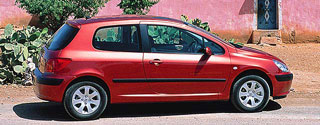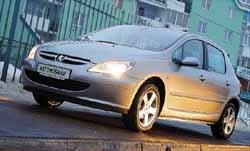PEUGEOT 307 Test drive 5 doors 2001 - 2005 hatchback
Beat the first, Leva!
For the answer, the French sent us not somewhere - to Morocco. Why here? Another riddle. Perhaps because here, it seems, there are no police officers, and chipper or at least pillars are not provided on narrow mountain roads.So, 600 km from the ancient city of Tarudant on passes and vice versa to understand what Lev No. 307 with gasoline engines 1.6, 2.0 and diesel HDI can claim.
They do not rise to the salon of the 307th, and even more so do not fall - they sit in it, as in a home chair. And all thanks to the body, the average in height between the hatchback and the one -coater.
The seats adjusted to almost a millimeter, excellent lateral support, the dashboard, a huge tilted windshield, is highly put forward, an unusually wide review around is forced to doubt that we are in the hatchback, and not in the minivan.
In fact, this is neither one nor the other. Rather, all together: French breeders brought in their incubator a new breed of hatchbacks with the characteristics of single -combatants.
A strict, well-organized monoblock of the dashboard of the 307th gives the impression of German thoroughness and seriousness. Soft and porous, pleasant to the touch, high -quality torpedo plastic is associated with expensive Audi, while the devices and blocks of the windows buttons new Peugeot suspiciously resembles Golf.
Today it is the most spacious model in its market segment: as wide as the Golf (1.73 m) record holder, but also the longest, the longest, ahead of Nissan almera (4.20 m versus 4.18), and the highest) (1.51 versus 1.43 for Ford Focus).
There is, however, at least one controversial moment: the ratio of the length of the salon itself and the volume of the trunk. From seventeen centimeters added to the old 306th model, only four fell. It could be assumed that the trunk will receive the lion's share of the remaining. However, the department for the transportation of cargo increased slightly - from 338 liters to the 341st. Thus, lengthening of the salon is almost completely subordinated to the convenience of the rear passengers. Perhaps this is good if you do not happen to carry gas cylinders and baby strollers to the country.
Finishing and interior - also five with a plus. Let's see how the French equipped their novelty.
On this side, Peugeot 307 also does not disappoint. The impression is as if you are dealing with a car for a class above. The 307th received ABS Bosch 5.3, disc brakes for all wheels, an amplifier system for emergency brakes, climate control with a refrigerator in a glove box, six airbags, rain sensor and automatic headlights in the dark, a six-player for six discs. Perhaps this part of the stabilization of the course stability (ESP), which is already installed on Golf, is not enough. However, its appearance here and the anti -circus system (ASR) is expected in the very near future.
Peugeot 307, like the 607th, is sold by order. There are six levels of interior equipment (XR Pressence, XT, XT Premium, XS, XS Premium and XSI) and five decoration options with beautiful names diamonds, cobalt, ivory, cedar, and titanium. Probably, only funny guys from the Peugeot marketing service are versed in the intricacies of these encryptions. Our advice - choose a poke method, it will still be beautiful.
Let's see how this lion behaves in motion. PSA specialists worked well on the ensemble of the suspension drive wheels. A completely new platform of the 307th (and in the future - and Citroen C4) uses the type of suspension with hydraulic shock absorbers of high pressure (3 bar) already tested on Renault Laguna, known for its endurance and resource of 150 (!) Thousands of kilometers. The machine is stable and obedient. A reinfected steering wheel with a hydraulic power steering that has a variable reinforcement coefficient allows you to feel the way excellent.
We must try very hard to provoke a skid. But with all this, with all this, it seems more acute and agile than, say, Golf, which, with its unshakability, really resembles a sumo fighter.
However, there is still a small sin of the 307th suspension: dislike of small irregularities on the road, and even more so to gravel. Small vibrations on pedals appear, and passengers feel uncomfortable. By the way, Golf also has the same feature. Only his vibrations do not go from the suspension, but from the engine.
Another nuance that distinguishes the Frenchman from the German is the strengthening of the side pitching in corners. Although - taking into account the unusual height of Peugeot - this circumstance looks natural.
All three engines offered to customers Peugeot 307 are well known. This is, firstly, 1.6 (110 hp), which first appeared under the hood of Peugeot 306; Secondly, a two -liter motor (138 hp) is the inheritance of Peugeot 406 and 206, and finally popular in Europe HDI (90 hp). Power units are offered so far with the same manual gearbox. But by the fall, they say, an automatic machine will appear.
In the segment of compact family cars (golf class), 55 percent of European sales fall on diesel modifications. The lion's share is 45 percent of gasoline engines - behind 1.6 liter engines. In two-liter engines, the audience is as strong and small as the fitness centers.
A turbodiesel under the hood of the 307th, as expected, is rather melancholy. Awakened by the ignition key, he grins slightly at idle, but in motion, confidently and calmly doing his work, becomes quieter. This ninety motor does not like fuss. It makes no sense to spur it, driving the arrow of the tachometer into the right limit. The engine is struggled to puff up to four and a half thousand revolutions, then, as if on command, it sours and not to remove it from this state even with a whip of a lower gear. In a word, the turbodiesel is designed for a calm and most importantly, economical ride from point A to point B.
In the fall, probably, a two-liter HDI will appear in 110 hp, equipped with a molecular filter and other innovations tested on Peugeot 607. Then, probably, the turbodiesella 307th will be parked not only near the clubs for those for 40, but also nearby, but also nearby With youth discos.
On the Peugeot 307 1.6 there is a 16-valve 110-horsepower Tu5 motor, migrated here from the previous model. This is perhaps the most quiet and balanced motor from installed on the 307th series. The noise level of it is so low that you have to constantly look at the tachometer.
Despite its 110 forces, the engine is much less cutting than you could expect. There is an explanation for this: Peugeot is not only heavy (152 kg heavier than Renault Megane), but also very aerodynamically loaded due to its dimensions, which, incidentally, leads to a large fuel consumption. Outside the city, the 307th per 100 km of path burns 2 liters more than Citroen Xsara with the same engine!
The resistance to rolling large tires is also affected - 205/55R16. But then such rubber contributes to better braking. PEUGEOT with the brake amplifier system and the distribution of the brake track can be stopped at 66 meters at a speed of 130 km/h - this is a class record.
The two -liter engine of the EW10 series is out of competition. The engine is powerful and at the same time elastic. It is spinning to the limit of 6500 min-1, without requiring intensive work of the Communist Party. High speeds and high power provoke a driver on a risky ride, which, in general, does not really fit with the appearance and purpose of the Peugeot 307.
This engine is significantly noisier than its stubborn counterpart, especially after 4000 min-1. And at the same time - much more agile. So much so that it may require insufficiently qualified steering to certain practical training.
Thus, we are offered three 307s with different characters; The price range is from $ 13,000 to $ 18000. According to consumer properties, the model is ready to compete not only with classmates, but also with individual representatives of high school. And most importantly, Peugeot 307 forms a new subspecies of cars with signs of hatchback, minivan and sports car. Probably, in a year or two we will see something similar among the Germans, but for now the 307th can share and rule.
Technical characteristics of Peugeot 307 1.6 16V // Peugeot 307 2.0 16V // Peugeot 307 2.0 hdi
Body - 5 -door hatchback
Number of places, people - 5
Equipped mass, kg - 1193 // 1219 // 1260
Complete mass, kg - 1693 // 1719 // 1760
Dimensions (length/width/height), mm - 4202/1746/1510
Base, mm - 2608
Maximum speed, km/h - 190 // 205 // 179
Acceleration time to 100 km/h, s - 11.7 // 9.8 // 13.8
Control consumption of fuel, l/100 km:
- City cycle - 9.5 // 10.9 // 6.9
- country cycle - 5.8 // 6.2 // 4.3
- mixed cycle - 7.2 // 7.9 // 5.2
Engine:
- type - gasoline // gasoline, 4 -cylinder, in order // diesel
- working volume, cm3 - 1587 // 1997 // 1997
- Power, L.S. at MIN -1 - 110/5750 // 138/6000 // 90/4000
- Torque, NM at MIN -1 - 147/3900 // 190/4100 // 205/1750
- power system - distributed fuel injection // Distributed fuel injection // Direct injection with the Common Rail system
Transmission - mechanical, 5 -speed
Tire size - 195/65R15 // 205/55R16 // 195/65R15
Wheel suspension:
- Front - independent, such as Mcpherson
- rear - independent, spring
Brakes:
- front - disk, ventilated
- rear - disk
Steering - rack, with an amplifier
Price (depending on the configuration), $ - 14800 // 18500 // 19100
Text: Andrey Bazarov
A source: Magazine 5 wheel [07/2001]
Video Crash tests Peugeot 307 5 doors 2001 - 2005
PEUGEOT 307 Test drives 5 doors 2001 - 2005
PEUGEOT 307 5 doors 2001 - 2001 - 2005
Krassh Test: Detailed Information30%
Driver and passengers
14%
Pedestrians











